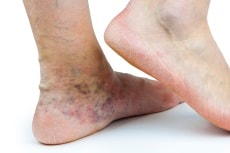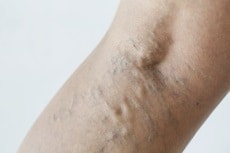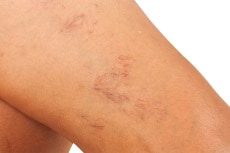Vein Care Services & Treatments
How do I know when to seek medical treatment?
See you doctor or the Bronson Vein Clinic if your legs hurt, ache, feel heavy, itch, cramp, are swollen or if you notice any color changes in your lower legs, ankles or feet.
Treatments
Treatment plans are decided on an individual basis. Once you come in for a vein screening, your care team will present your options and help you choose the best course of care. Treatment options range from non-invasive option to surgical treatment options.
Compression Stockings
This is a non-invasive treatment that will help squeeze the veins and help blood to travel back up to the heart. Compression helps by decreasing the backflow of blood and pressure on the veins. These will often reduce the symptoms of venous disease and may help prevent worsening of symptoms.
There are many medical supply stores that sell compression stockings. Some insurance plans will cover the cost if they are prescribed by a provider. If you receive cosmetic treatments for varicose veins you will be required to purchase a pair of light compression stockings to wear after your treatments.
Phlebectomy
This procedure is the surgical removal of varicosities. This can be performed in the clinic under local anesthesia and a small incision. However, it may also need to be performed in the operating room for more extensive cases. It is often performed when treating the varicose veins that may not be good candidates for ablation or sclerotherapy.
Radiofrequency Ablation
This is a minimally invasive varicose vein treatment procedure. This is performed in the office. A small catheter is placed under ultrasound guidance and local anesthesia into the affected vein. Radiofrequency energy is used to treat the specific vein that is causing problems. After treatment, the vein will collapse and scar down. Blood will then be routed and returned to healthy veins to be entered into circulation.
What to Expect During the Procedure
You will be asked to stand for 30 minutes before the start of the procedure. Once in the procedure room, you will change into a gown. The leg we will be treating will be prepared for the procedure. Before and after pictures may be taken. These will be used to show the results.
What to Expect After the Procedure
You will see a reduction of symptomatic veins and decrease in the associated varicose veins. You should notice a change within a few weeks after the procedure with the final results typically seen 2 to 3 months after the procedure.
View the full pre- and post-procedure instructions.
Sclerotherapy
Sclerotherapy is the injection of a liquid or foam agent that collapses superficial veins that are unwanted or painful. This is an excellent treatment option for smaller veins, but is not for everyone.
What to Expect During the Procedure
During this procedure, another thorough exam of your veins will take place. The problem veins will be identified and discussed. Before and after pictures may be obtained to track your results. The practitioner will clean the surface of your skin over the veins with an alcohol swab. A small needle will be used to inject the sclerotherapy agent directly into the veins. This will feel like a modest prick. Bandages are placed after the injections are complete. Compression stockings are placed over the bandages. You will remain lying with your head elevated for 15 minutes after the procedure.
What to Expect After the Procedure
The treated veins will fade within a few weeks, although it may take a couple of months to see the final result.
View the full pre- and post-procedure instructions.
Testing
Duplex Ultrasound
This is a painless procedure performed in the clinic that gets detailed information of the veins. This will help us evaluate the vein size and measure the speed of blood flow to evaluate for the presence of reflux (backward flow of blood through the vein). This will give us the information needed to be able to identify and treat the appropriate veins that are causing symptoms. It can also be performed to rule out conditions such as deep vein thrombosis (DVT) and superficial thrombophlebitis.
Relief for vein conditions
We treat a wide range of conditions from the common to the complex. If you need care for a condition not listed here, consult with one of our heart and vascular providers. Commonly treated conditions include:
Chronic Venous Insufficiency
 This is a condition that affects the veins in the legs. When you have chronic venous insufficiency, the legs do not pump blood and fluid back up to the heart well. This is typically caused by weakening of the vein walls. It can also be caused by problems with the valves inside the veins.
This is a condition that affects the veins in the legs. When you have chronic venous insufficiency, the legs do not pump blood and fluid back up to the heart well. This is typically caused by weakening of the vein walls. It can also be caused by problems with the valves inside the veins.
In a normally functioning vein, blood from the extremities is directed back up to the heart to be re-oxygenated. The damaged or weakened veins can allow blood to reflux back down the leg instead of continuing to flow back up to the heart.
Venous insufficiency can lead to conditions over time such as edema, varicose veins, reticular and spider veins, venous stasis ulcers and skin changes.
Varicose Veins
 Varicose veins affect the superficial veins in the legs. These are dilated, bulging veins that typically appear on the lower extremities.
Varicose veins affect the superficial veins in the legs. These are dilated, bulging veins that typically appear on the lower extremities.
This is a result of venous insufficiency, a condition in which the veins to not function properly. This causes blood to pool in the veins and can lead to swelling and discomfort.
There are several factors that can put you at risk for vein problems, including:
- Genetics
- Age
- Gender
- Changes in hormones
- Occupation
- Height
- Weight
Spider Veins
 These are bluish or reddish veins that are easily seen under the skin’s surface. Spider veins may or may not cause symptoms and can be easily treated.
These are bluish or reddish veins that are easily seen under the skin’s surface. Spider veins may or may not cause symptoms and can be easily treated.
Venous Stasis Ulcers
Venous stasis ulcers are wounds in your lower legs. This is a complication of venous insufficiency which leads to chronic inflammation, edema, pigment changes and ulceration of the skin. The ulcers may become a chronic problem, making one prone to infection. You should reach out to your primary care provider right away if you suspect you may have a venous ulcer. Venous ulcers are very unlikely to get better on their own and often require medical treatment by a specialist. Your provider may recommend an appointment with a wound or vascular specialist at Bronson Vascular and Endovascular Surgery Specialists. Learn more about vascular services.
Learn more about venous ulcers and ways to prevent and treat these sores.
What can I do to improve my veins?
- Keep your legs moving. Walking, cycling and swimming all help keep blood circulating in your legs.
- Maintain a healthy weight. Reducing body weight can help you prevent or better manage varicose or spider veins. Sustaining a healthy wait minimizes the excess pressure on your legs that can cause veins to surface and bulge.
- Wear compression stocking to alleviate pressure to veins. Support hose ensures that pressure is evenly distributed on your legs.
What things should I avoid to protect my veins?
- Sitting or standing for long periods of time.
- Exposing your legs to excessive heat.
Schedule a vein screening today
No referral is required. To schedule an appointment, call (269) 341-7333 or request an appointment online.
Request a Free Vein Screening
If you require a medical evaluation by a vascular provider to diagnose your venous disease and provide vein treatment options, you may need to return to the office a second time before receiving a recommended treatment plan. You should expect your visit to last about 30 minutes.